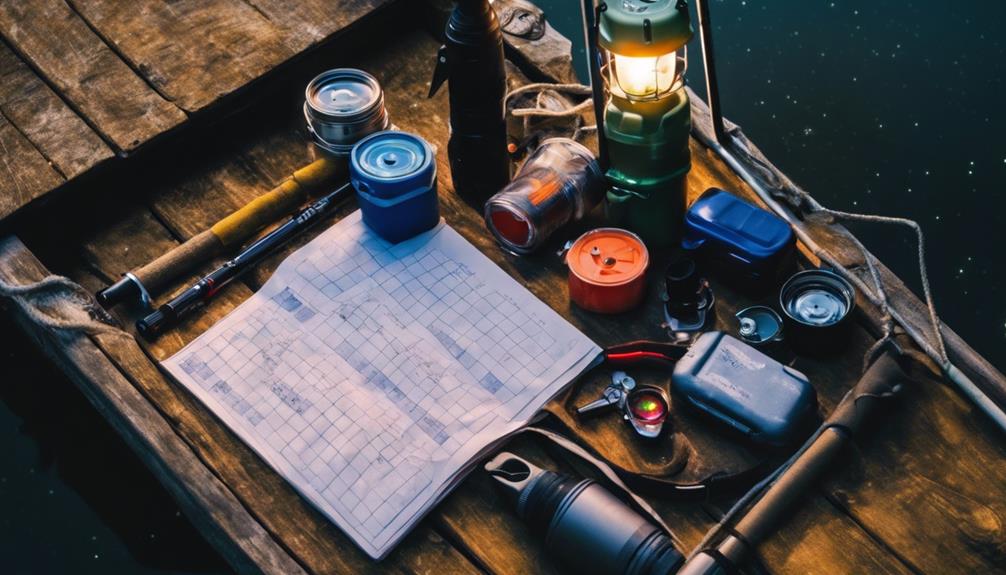To maximize your night fishing success, utilize your fish finder's full potential with strategic adjustments for low-light conditions. Take advantage of sonar technology to pinpoint fish accurately. Adjust frequency settings – higher for detailed shallow water scans, lower for deep water coverage. Properly calibrate depth range to scan effectively. Mount the transducer correctly for precise readings. Interpret sonar data by identifying fish patterns like arches or lines. Fine-tune sensitivity and contrast for clearer visuals in the dark. Consider night vision technology for better visibility. Safety measures are vital for secure night fishing. Enhance your fishing experience with optimized fish finder use.
Benefits of Using a Fish Finder
When fishing at night, utilizing a fish finder can significantly enhance your ability to locate and target fish more efficiently. The advantages of sonar technology in fish finders are particularly beneficial during nighttime fishing sessions. Sonar advantages include the ability to detect underwater structures, schools of fish, and individual fish with high precision. This technology emits sound waves that bounce off objects in the water, providing detailed information about what lies beneath the surface.
Night visibility is often limited, making it challenging to spot fish without proper equipment. Fish finders equipped with bright, easy-to-read displays offer enhanced visibility in low-light conditions. The contrast and brightness settings can be adjusted to ensure that the information displayed on the screen is clear and visible even in the dark. This feature is especially useful when trying to differentiate between various underwater elements or when monitoring fish movements in real-time.
Understanding Sonar Technology
Utilizing sonar technology in fish finders offers a detailed and precise method for detecting underwater structures and locating fish efficiently, especially advantageous during nighttime fishing sessions. Sonar operates by emitting sound waves into the water and then interpreting the echoes that bounce back. The frequency of the sonar wave plays a crucial role in determining the level of detail the fish finder can provide. Higher frequencies, such as 192 or 200 kHz, offer greater detail and are ideal for shallower waters up to around 200 feet. On the other hand, lower frequencies like 50 kHz can penetrate deeper waters, reaching depths of up to 900 feet, but may sacrifice some detail.
When setting up your fish finder for night fishing, understanding the depth range of your sonar is essential. The depth range indicates how deep the sonar can effectively scan and display information. Fish finders typically come with depth ranges that can vary from 200 to 1000 feet or more, depending on the model. It's crucial to adjust the depth range on your fish finder according to the waterbody you're fishing in to ensure you're covering the relevant depths where fish might be present. By utilizing sonar technology effectively, you can maximize your chances of a successful night fishing expedition.
Setting Up Your Fish Finder
To optimize the performance of your fish finder for night fishing, precise calibration of its settings becomes crucial. Proper installation is the first step in ensuring your fish finder functions effectively. Start by mounting the transducer correctly, making sure it's submerged in water and free from any obstructions that could interfere with sonar waves. Position the display unit in a convenient location where it's easily visible and accessible.
Next, familiarize yourself with the various settings on your fish finder. Adjust the sensitivity to eliminate clutter on the screen and make it easier to distinguish fish from debris. Set the depth range according to the waters you'll be fishing in to ensure you're effectively scanning the area where fish are likely to be present. Experiment with different frequencies to find the one that provides the best clarity for detecting fish.
If you encounter any issues with your fish finder, knowing some troubleshooting techniques can be helpful. Check the power source to ensure it's properly connected and supplying the device with adequate power. Inspect the transducer for any damage or loose connections that could affect its performance. Resetting the fish finder to its factory settings can also resolve certain technical issues. By following these tips for setting up and troubleshooting your fish finder, you can enhance your night fishing experience.
Interpreting Sonar Readings at Night
For optimal night fishing success, understanding how to interpret sonar readings accurately is essential. When interpreting sonar readings at night, pay close attention to the depths displayed on your fish finder. Different fish species tend to occupy specific depth ranges, so identifying the depth at which fish are located can significantly increase your chances of a successful catch.
As you analyze the sonar readings, look for distinct patterns that may indicate the presence of fish. Fish typically appear on the screen as arches or lines. Larger fish tend to produce stronger sonar returns, appearing as thicker lines or more pronounced arches. By familiarizing yourself with these patterns and characteristics, you can improve your ability to identify different fish sizes and species.
Furthermore, understanding the behavior of fish in relation to depth is crucial for effective interpretation. Some species prefer to stay close to the bottom, while others may be suspended at various depths in the water column. By correlating the depth information from your sonar with the known behavior of different fish species, you can make more informed decisions about where to focus your fishing efforts.
Adjusting Settings for Low Light
Adjust the sensitivity and contrast settings on your fish finder to optimize visibility and detection during low light conditions for enhanced night fishing performance. When fishing at night, having the right settings on your fish finder can make all the difference.
Start by adjusting the sensitivity to a higher level to ensure that even the slightest of movements underwater are detected. This heightened sensitivity is crucial for night fishing when visibility is limited. It allows you to pick up on faint signals that may indicate the presence of fish.
Additionally, adjusting the contrast settings on your fish finder can improve night vision by enhancing the distinction between different objects and structures underwater. Increasing the contrast can make it easier to differentiate between fish, vegetation, and the bottom of the water body. This adjustment is particularly useful in low light conditions when details may be harder to discern.
Utilizing GPS Features for Navigation
Enhance your night fishing experience by harnessing the GPS features on your fish finder for precise navigation in low light conditions. GPS navigation is a crucial tool for ensuring you stay on course and reach your desired fishing spots efficiently. By utilizing GPS on your fish finder, you can accurately mark waypoints, track your position, and navigate back to specific locations even in the dark.
When engaging the GPS navigation feature, ensure that you set your desired coordinates correctly to navigate to your chosen fishing grounds. The GPS system on your fish finder can provide real-time information about your location, helping you avoid hazards and stay on the right track. Additionally, take advantage of the depth tracking feature in conjunction with GPS to ensure you're fishing at the optimal depth for the type of fish you're targeting.
Tips for Optimizing Fish Finder Performance

To optimize your fish finder performance, ensure proper calibration of the sonar settings to accurately identify fish and underwater structures. Sonar troubleshooting is essential for maximizing the effectiveness of your fish finder in different conditions, including at night. Here are some tips to enhance your fish finder performance:
- Adjust Sensitivity Settings: Fine-tuning the sensitivity settings on your fish finder can help eliminate clutter on the screen and provide a clearer view of fish and structures underwater. Start by setting the sensitivity to a low level and gradually increase it until you begin to see the information you need without unnecessary noise.
- Utilize Color Palettes: Many modern fish finders come equipped with different color palettes that can enhance the visibility of underwater details. Experiment with the color settings to find the one that works best for your night fishing conditions. For example, using a palette with contrasting colors can make it easier to distinguish between fish arches and the bottom.
- Explore Night Vision Technology: Some advanced fish finders offer night vision technology that uses infrared imaging to provide a clear picture of what's happening underwater in low-light conditions. Consider investing in a fish finder with night vision capabilities for improved visibility during your night fishing expeditions.
Safety Precautions for Night Fishing
For safe night fishing practices, understanding and implementing essential safety precautions is paramount to ensure a secure and successful fishing experience. When venturing out for night fishing, it's crucial to have emergency protocols in place. Make sure to inform someone of your location and expected return time. Carry a fully charged phone and a backup power source for communication in case of emergencies. Additionally, familiarize yourself with the area's emergency contact numbers and the nearest medical facilities.
Night vision is a critical aspect of staying safe while fishing after dark. Invest in high-quality night vision gear or use a headlamp with red light to preserve your night vision. Avoid looking directly at bright lights, as it can impair your ability to see in the dark. When setting up your fishing spot, ensure that your lighting is sufficient to navigate safely without attracting unwanted attention from wildlife.
Wildlife encounters are a possibility during night fishing. Be aware of your surroundings and make noise periodically to alert animals of your presence. Proper lighting not only helps you see better but also alerts wildlife to your presence, reducing the chances of surprising them. Remember to respect the natural habitat and avoid disturbing the wildlife. By following these safety precautions, you can enjoy a successful and secure night fishing experience.
Frequently Asked Questions
How Can I Prevent Interference With Other Electronic Devices on My Boat?
To prevent signal interference with other electronic devices on your boat, troubleshoot by adjusting the placement of each device.
Ensure proper grounding and separate power sources to avoid conflicts.
Verify device compatibility and update firmware if needed.
Use shielding materials or distance devices to reduce interference.
Employ filters or isolators for specific frequencies.
Follow manufacturer guidelines for optimal performance and consider professional assistance for complex issues.
Can I Use a Fish Finder in Freshwater and Saltwater Environments?
Yes, you can use a fish finder in both freshwater and saltwater environments. The device's depth accuracy is crucial for distinguishing between different fish species and understanding their behavior.
In saltwater, the fish finder helps identify underwater structures where fish might gather. In freshwater, it aids in locating fish at varying depths.
Target identification is key to successful fishing expeditions in both types of environments.
What Is the Best Way to Clean and Maintain a Fish Finder?
To keep your fish finder in top condition, remember to store it properly when not in use.
Regular calibration ensures accurate readings.
Periodically deep clean the device, paying attention to waterproof seals.
These steps help maintain the fish finder's functionality and longevity.
Are There Any Specific Fishing Techniques That Work Well With a Fish Finder?
When using a fish finder, consider lure selection and fish behavior to enhance your fishing technique.
Pay attention to trolling speed and casting accuracy to target specific areas where fish are likely to be.
By understanding how the fish respond to your tactics, you can adjust your approach for better success.
These details can help you make the most of your fish finder and increase your chances of a successful night fishing trip.
How Do I Troubleshoot Common Issues With My Fish Finder's Display?
To troubleshoot common issues with your fish finder's display:
Start by checking the display calibration. Ensure the settings are optimized for visibility.
Next, investigate any power issues that may be affecting the display.
If the problem persists, review your sonar settings and adjust them accordingly.
For any GPS-related troubles, troubleshoot by verifying the connections and updating the software if needed.
Following these steps should help resolve most common display issues.
Conclusion
In conclusion, maximizing the use of your fish finder during night fishing can greatly increase your chances of a successful catch. By understanding sonar technology, setting up your fish finder correctly, interpreting sonar readings, adjusting settings for low light conditions, utilizing GPS features, and following safety precautions, you can optimize the performance of your fish finder and enhance your overall fishing experience.
Remember, proper preparation and utilization of your fish finder are key to a fruitful night fishing excursion.



